Jellyfish are a fascinating – and slightly gruesome invertebrate species. Jellyfish have no brain, no blood, and no heart, and are 95 per cent water. Floating along in the sea for millions of years, fossilised imprints of prehistoric jellyfish unearthed in Utah 2007 from about 540 million years ago tell us their design has barely changed.
Warmer weather conditions is bringing in a wider diversity of jellyfish species to our shores. Research by the Marine Conservation Society shows an increasing trend in some species being spotted on our shores over the last 20 years, such as Portuguese man o’War. Data suggests that an increase in some jellyfish numbers around UK could be related to climate change, however more evidence is currently being gathered by scientists. Generally, there are six common jellyfish species found in the UK.
Learn more about jellyfish, including how to identify, what they eat and how to treat stings in our expert guide.
Discover more wildlife found on the UK coast with our guides to rockpool species, whales and dolphins and seabirds.
When do jellyfish appear in British waters?
In spring and summer, jellyfish start to arrive in the UK warmer waters to feed on plankton blooms, eggs and larvae of fish, and crustaceans. Jellyfish blooms, or ‘smacks’, peak at the height of our summer, and this is when the adult males release their sperm into the sea. The nearby females in the smack suck the sperm up through their mouth into their stomachs where fertilisation occurs.
The stretch of the Bristol Channel between the Gower Peninsula and the North Devon is the UK’s hottest spot for huge jellyfish blooms.
What do jellyfish eat?
The opening to a jellyfish’s stomach serves as both mouth and anus. The jellyfish diet is varied and consists of small plants, fish, fish eggs, shrimp and crabs. Some jellyfish species even eat other jellyfish!
Jellyfish tentacles are lined with thousands of stinging cells known as nematocysts. Each cell contains a spring-loaded, toxic harpoon designed to paralyse and secure prey – plankton and small fish.
What eats jellyfish?
Leatherback turtles feed almost exclusively on jellyfish. Each year they perfectly time their epic migrations to UK seas to coincide with peak jellyfish numbers in July and August.
Jellyfish numbers are rising. Studies show that overfishing of plankton-eating fish, such as herring, which predate on the early life stages of jellyfish and compete with the adults, can tip the ecological scales in favour of jellyfish. Collapsing fish stocks have been quickly followed by increasing jellyfish numbers in in the Irish Sea, the South Atlantic and the Mediterranean. Global increases in jellyfish numbers have also been linked to warming sea temperatures through climate change.
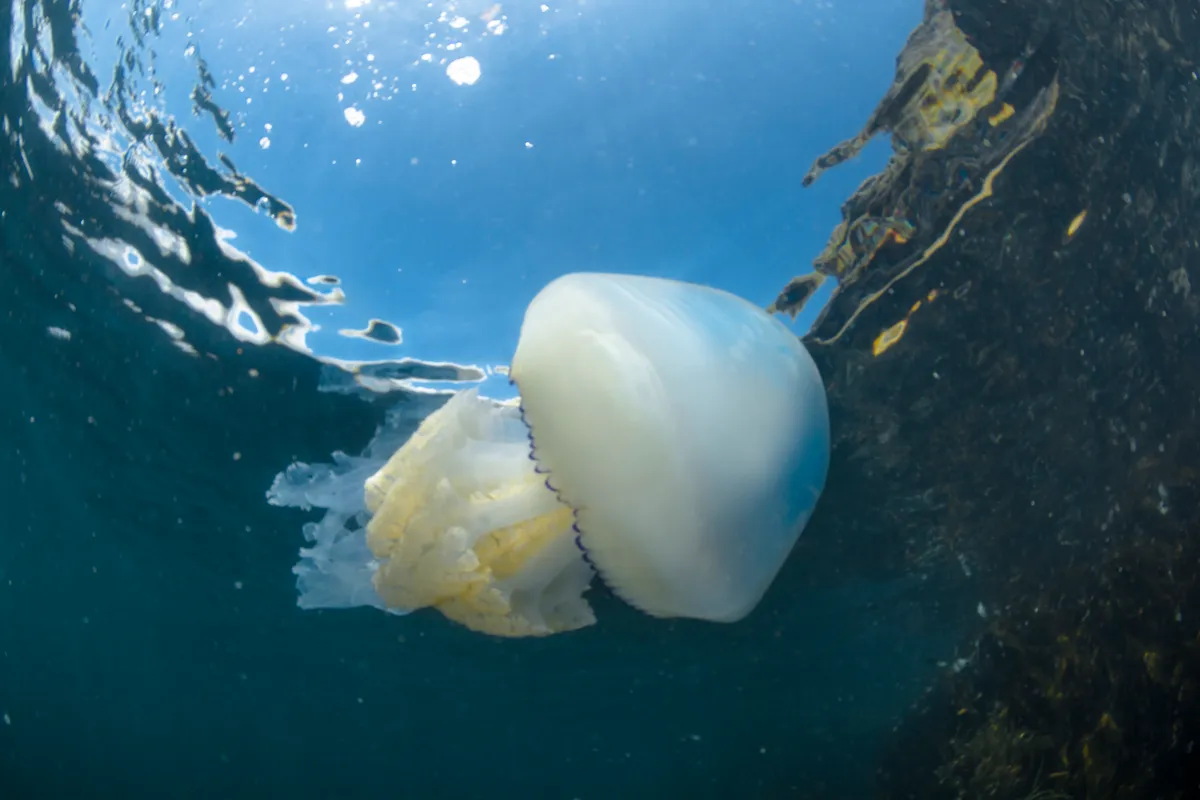
What jellyfish species are found in the UK?
Globally, there are thousands of jellyfish species floating in our oceans, however there are just six common jellyfish species that appear in British waters.
Lion's mane (Cyanea capillata)

Measuring up to 2 metres in diameter, the lion’s mane is one of the UK's largest jellyfish. Also sometimes known as the giant jellyfish its longer tentacles reach tens of metres in length.
Blue jellyfish (Cyanea lamarckii)

A similar shape and size to the lion's jellyfish, the blue jellyfish is translucent when young before maturing into a vibrant blue/purple colour. It can measure up to 30cm across and tends to appear in UK waters in late summer and autumn.
Compass jellyfish (Chrysaora hysoscella)
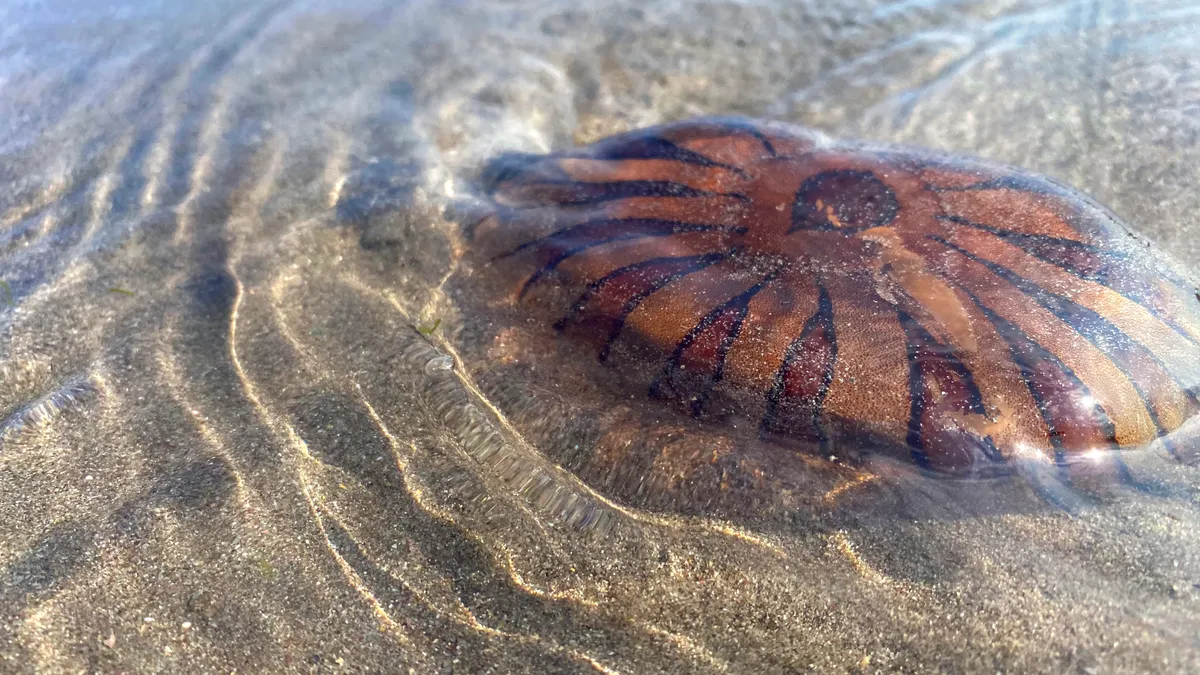
Compass jellyfish often wash ashore in the summer months so be careful when walking barefoot along the shoreline as this common species can give a nasty sting. This translucent yellowish-white jellyfish has brown markings which resembles a compass.
Barrel jellyfish (Rhizostoma pulmo)
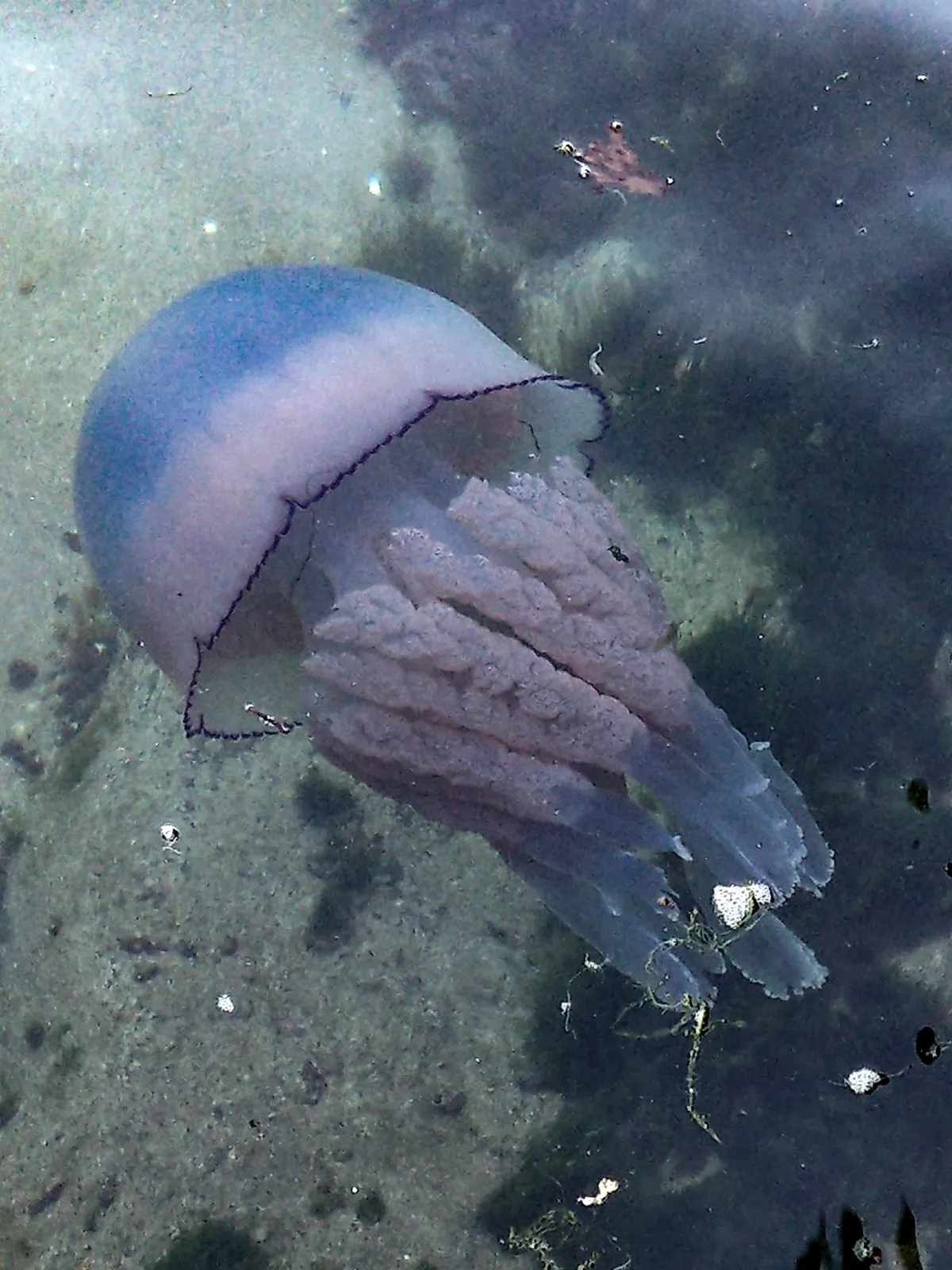
The enormous barrel jellyfish is the largest in the UK. Sometimes nicknamed the dustbin-lid jellyfish thanks to their size, the barrel jellyfish swarms the British coastline in May and June when warmer waters entice them in. Their diet tends to consist of plankton.
Moon jellyfish (Aurelia Aurita)
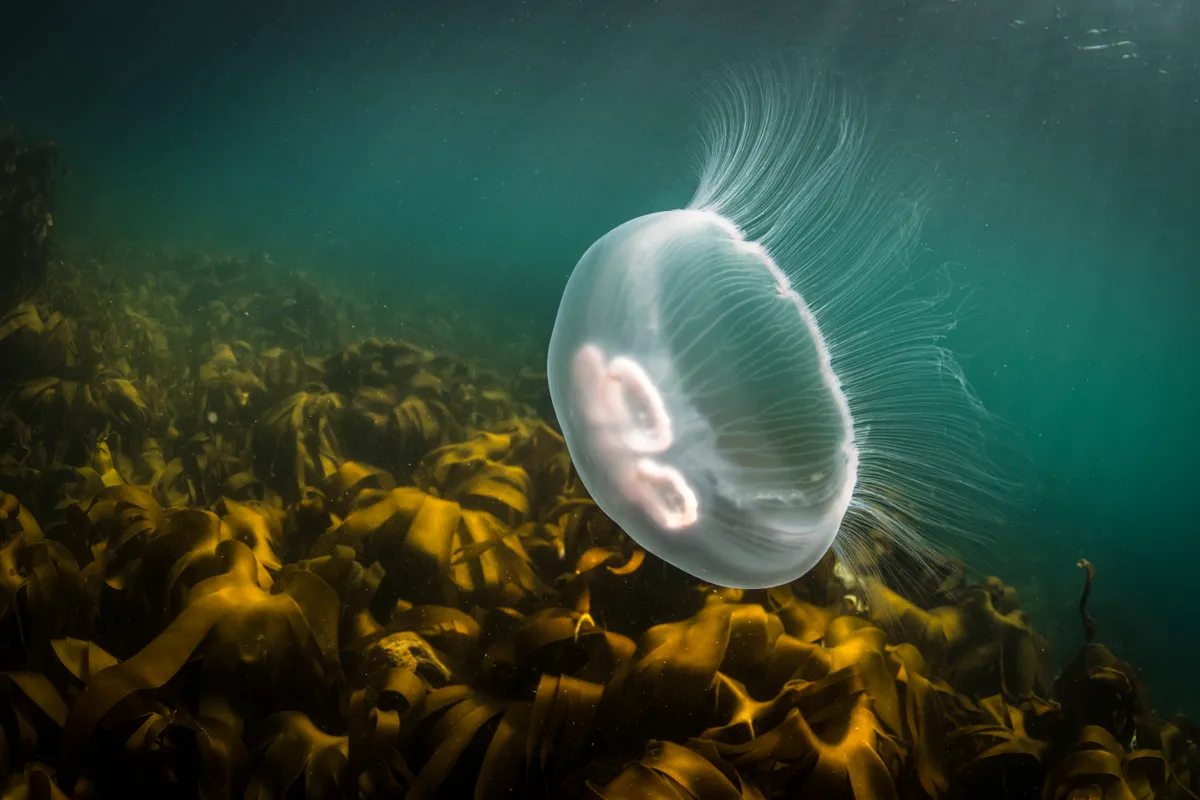
Resembling a moon in appearance with four distinctive circles on its white milky dome, the moon jellyfish is roughly the size of a dinner plate and lives for around six months. Found worldwide it reaches the UK's shorelines in the winter months.
Mauve stinger jellyfish (Pelagia noctiluca)

A toxic jellyfish with a powerful sting, the mauve stinger jellyfish is one you want to avoid while swimming. One of the smaller species of jellyfish, it is impressive looking with a bright purple/yellow dome which is covered in orange warts. You're less likely to spot this jelly close to the UK shore as it tends to float further out at sea or in warmer waters.
Report a jellyfish sighting
Contribute to marine conservation work and report any jellyfish sightings to the Marine Conservation Society.
The Marine Conservation Society’s Wildlife Sightings programme aims to collect long term data which can be used as a reference to study the reality of jellyfish trends in UK waters.
Dr Peter Richardson, Head of Ocean Recovery at the Marine Conservation Society, said: “Since 2003, when our Wildlife Sightings programme began, you’ve reported over 18,000 sightings of jellyfish and turtles. We want to reach 20,000 sightings to mark our 20th year of tracking these species. Every contribution to our database is crucial in learning about our seas and helps us fight to protect them.”
The Marine Conservation Society uses wildlife sightings by citizen scientists to:
· Discover how jellyfish and turtle populations are changing around the UK – specifically when and where they are occurring each year.
· Investigate trends in turtle sightings to find out more about how they use our waters.
· Explore whether jellyfish distribution can tell us more about where leatherback turtle feeding grounds.
What does a jellyfish sting look like?
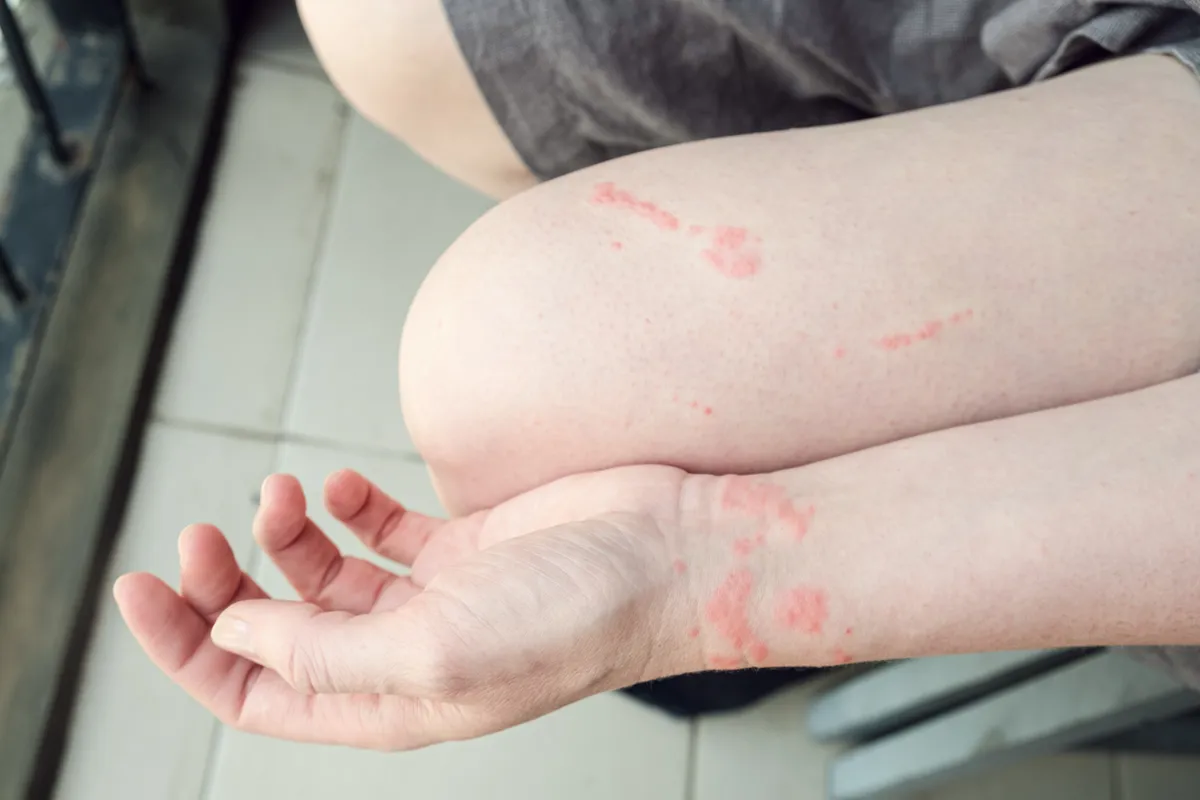
Jellyfish stings will leave a rash and can be quite painful with a burning sensation. The sting tends to be line of red, raised welts or blisters which will leave an itchy rash.
How to treat a jellyfish sting?
Jellyfish found in the UK don't tend to be dangerous, unlike the deadly Box jellyfish which is found in Australian waters and injects a poison as it sting. That said, a jellyfish sting can be painful, so it is worth taken some caution when you swim in the sea and avoid times and areas where jellyfish are swarming.
Here's what to do if you are stung by a jellysfish:
1. Firstly, do not panic. A nasty sting can be a shock to the system but try to stay calm – especially, if you're out of your depth.
2. If you are in the water get out, and thoroughly rinse the affected area with sea water immediately. Do not use urine. Wash the area with clean, warm water to reduce the chance of infection.
4. So long as the stinging tentacles are on you they will continue to inject you with the toxin, and worsen the effect. If you can see them, remove them with a stick or tweezers.
5. Apply an ice pack if available.
6. For the medical advice see: nhs.uk/Conditions/Stings-marine-creatures/Pages/Treatment.aspx or seek a medical specialist straight away if the pain increases and you experience shortness of breath or chest pains.

